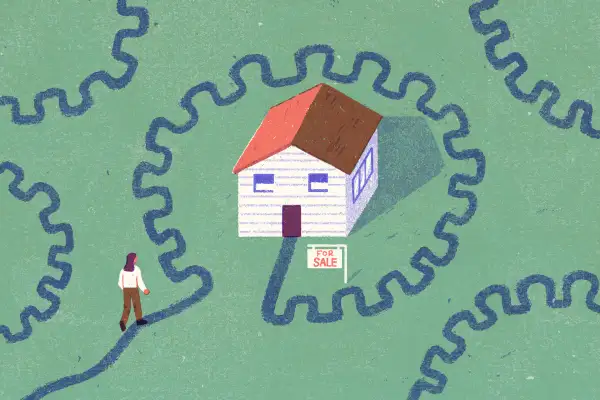The New Rules for Buying a House in 2021

If you’re ready to take the plunge into homeownership, get a head start on packing.
Much of how coronavirus pandemic has reshaped the buying process is just starting to become clear. While some steps have slowed (like getting approved for a mortgage) most others have sped up significantly compared to a year ago as low mortgage rates and changing household needs are leading to intense competition.
One example? According to the National Association of Realtors, 72% of homes sold in October 2020 went to contract in less than a month, down from 36 days in October 2019.
“What we’re seeing lately is that homes that are listed for sale don’t stay on the market very long,” said Frank Nothaft, chief economist for data analytics provider CoreLogic. “There’s a contract that’s placed on the property pretty quickly. So days on the market have actually gotten shorter, and home prices have gone up.”
1. Forget the spring homebuying season
Coronavirus lockdowns and restrictions on home tours threw the housing market a curveball in the spring, usually the busiest time of year for sales.
“What happened is we had a shifted seasonal pattern,” said George Ratiu, senior economist with Realtor.com. "Summer became spring, and then we saw the activity in terms of demand for housing continue well into this fall.”
In October, existing home sales grew to a seasonally-adjusted annual rate of 6.85 million — the highest pace since 2006.
“The surge in sales in recent months has now offset the spring market losses,” said Lawrence Yun, chief economist for NAR. “With news that a COVID-19 vaccine will soon be available, and with mortgage rates projected to hover around 3% in 2021, I expect the market’s growth to continue into 2021.”
Low mortgage rates and the rise of remote work have been driving home-purchase decisions. In a normal year, a significant share of buyers would base their home purchasing decisions around the start of the school year.
Remote work “has driven people to seek better solutions to what they discovered in the era of COVID,” added Ratiu. “All of a sudden our homes are no longer big enough. So that drove demand.”
2. Start your search online
The way prospective buyers shop for homes has evolved rapidly over the course of the pandemic. For instance, virtual tools such as 3D home tours provide a better sense of how a property flows than just photos can.
“Pre-pandemic we had some agents starting to use video,” said Nothaft. “But once the pandemic hit, we saw agents really move much more actively towards using video tools, including 3D imagery to market the homes. While we do not have data to confirm this yet, anecdotal stories do suggest that online shopping has reduced the number of homes that buyers visit.”
3. Prepare for bidding wars by getting pre-approved for a mortgage
According to NAR there were 1.42 million existing homes on the market at the end of October. At the current pace of sales that’s only a 2.5 month supply — a record low.
In competitive markets, buyers should have financing lined up and prepare for simultaneous offers in a bidding war. Every month since May, brokerage Redfin has said that more than half of offers made by their agents have faced competing bids. It’s common for multiple offers to come in for a home, including from investors in the entry to mid-level price segment paying for properties with cash.
“When that happens, that’s what triggers the bidding war between different prospective buyers and causes ultimately the price to be pushed higher,” said Nothaft, advising buyers to get pre-approved for a mortgage before starting a serious search.
Sellers “will look at the price being offered, but they will also look to see whether one buyer has an easier path toward closing than the other competitive offers,” he explained. “If you are already pre-approved for a mortgage of the right size, that can give you a leg up.”
4. Decide what compromises you can live with
Finding a home is often a compromise between what you want and what you can afford. If you have a champagne taste on a beer budget, do the math on the down payment, lender’s fees and property taxes.
Higher deposits, full-price offers and escalation clauses are common right now. Some buyers are waiving appraisal and inspection contingencies to make their offers more attractive to home sellers. Some are going as far as allowing sellers to continue living in the house after closing.
Ratiu recommends getting well acquainted with the local housing market. “Even within a metropolitan area, there are different submarkets which may actually behave a little bit differently,” he said. “There could be certain neighborhoods that are very hot, in which a home comes on the market priced well, and you could have 10 to 15 offers. Just a few neighborhoods over, that same process might look like two or three offers on a house.”
5. Prepare for the underwriting process
More mortgage providers have been offering borrowers the ability to complete and electronically sign the application package online, delivering disclosures electronically, and allowing remote notarization. What was once a paper-heavy and often cumbersome process is starting to be streamlined, significantly reducing time and effort.
Lenders have adapted to seller reticence to letting people enter their homes by allowing appraisal waivers, which give qualified loan applicants the option to forgo the traditional method of appraising a home. Some appraisers are relying on drones or applications such as Zoom to see the exteriors and interiors of properties.
More sophisticated virtual tour solutions can guide homeowners through the photo-taking process, filtering photo submissions to ensure they are current and specific to the property being appraised, and automatically flowing photos and data into an appraisal report.
6. Hurry up and wait
The closing is the perfect ending to the home story you have been waiting for — but be prepared to hurry up and wait. According to mortgage technology provider Ellie Mae, on average it took 54 days to close a loan in October. That’s ten days longer than the same month last year. Lenders have been swamped with processing loan applications due to historically low mortgage interest rates and high demand.
Several other issues could delay the mortgage closing process, causing the underwriter to reject the loan, including a change in your credit score or income, if the appraisal is lower than the agreed price, the home inspection reveals problems that need to be addressed, or there are problems with the title.
But once you get to the final step of the homebuying process, the closing should be much quicker than a traditional in-person closing of the past where you might take off work to drive to a title company to sign the mortgage and other documents.
“A lot of states are passing remote notarization acts, allowing title companies and agents to close without the need to be in the same physical space,” said Ratiu.
Lenders have begun accepting electronic signatures. Curbside and remote mortgage closings have become a logical extension of signing loan documents and distributing money at the office of a title company or escrow office.
The stacks of paper that have been a standard component of a home purchase transaction may soon be a thing of the past. The total documentation required to close a traditional home sale — including the loan paperwork along with title, tax and various other legal documents—generally totals around 200 pages.
“Buyers are finding an environment, even with the challenges of social distancing, where the process is being streamlined and adjusted to this new landscape,” said Nothaft.
More from Money:
Finding a Home Is so Hard Right Now That Buyers Are Scouring Obituaries and Divorce Notices
Savvy Homebuyers Are Using an Under-the-Radar Strategy to Win Bidding Wars in 2020
Why This Winter Should Be One of the Best Ever for Home Sales
